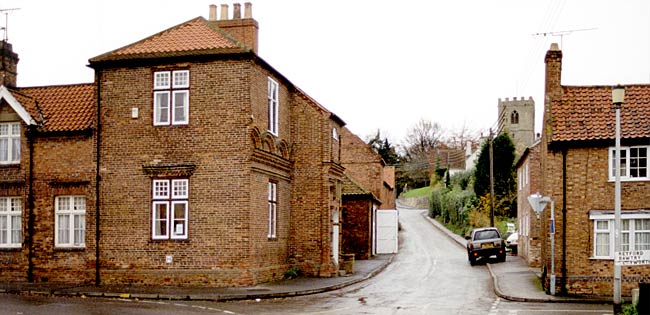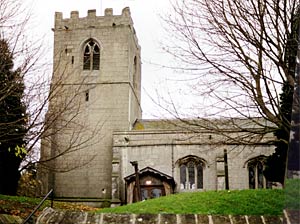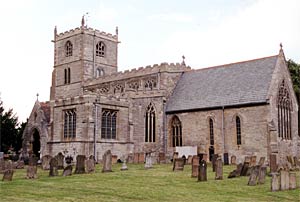< Previous | Contents | Next >
The Wonderful Stairs
NORTH WHEATLEY. Its red houses, grey church, and gaunt old windmill without sails climb a gentle hill between the River Idle and the Trent. Orchards and trees add to its charm, and in the heart of the village is the handsome Old Hall of 1673, a farmhouse now, with the arms of the Cartwrights over the entrance, and a pretty display of ornamental brickwork.

The 17th century manor house, North Wheatley (2001).

North Wheatley church (2001).
Set among limes and elms and a fine beech is the small aisleless church, which has a 15th century tower, a chancel made new last century, a new timbered porch, and a story as old as the huge Norman font. A curious relic projecting from the wall, looking like a stoup, is really a mortar with stone bands. The nave has a medieval piscina and old tie-beams in its roof; the 17th century pulpit and the old rood beam across the tower arch are partly restored, and 25 traceried bench-ends come from about 1500.
A wonderful oak stairway to the platform where the bellringers stand is a fascinating possession; grey with age, it has 28 steps of roughly trimmed and quartered logs secured with wooden pegs to two stout beams, each of which is over a yard round near the top.
A brass inscription to a London wine dealer of 1445 is a memorial for a second time, for on the other side is an epitaph to Joan Cokesay. Adam Haket's 15th century floorstone has a cross and coats-of-arms. There are three Elizabethan chalices and three small Jacobean altar tables. Two 13th century shafts support stone tables under the tower and in the vestry.
There is a delightful view of the village from South Wheatley half a mile away, the home of a few folk who lost their church half a century ago. Its chalice and altar table are with those at North Wheatley, and its ancient font is in a Nottingham church. In the old churchyard stands the tiny Norman chancel arch, looking across what was once the nave to the 15th century tower, with its arch built up and two of its pinnacles gone.
Northwell No More
NORWELL. It was once important with a market and a fair, three prebends of Southwell Minster, and six moated houses; the old water moat of one of them is by the churchyard where meadows go down to the Beck. Now it is content with its farming. Even its name has changed, though the old Northwell (distinct from Southwell) is still seen on the church plate.

Norwell church.
The church stands in a churchyard with fine elms and chestnuts, and a sundial 200 years old. It came into Domesday Book, and there are remains of Norman days in the fine grey pile. With transepts and a splendid western tower with a domed cap, it is beautiful indoors and out. Except that it was topped and pinnacled in the 15th century, the tower is 13th century. The 600-year-old porch, with a modern St Lawrence over the entrance, shelters a splendid Norman doorway with detached pillars. The north arcade is as old as the porch, but the south, with round pillars and scalloped capitals, comes from,about 1190. Each arcade has a smaller arch at the west end, resting on 13th century corbels.
The village is proud of its church's medieval windows. The long lines of the clerestory on each side show quatrefoils in diamond-shaped tracery. The 700-year-old arch frames a lovely picture of the chancel with some lancets, and a 14th century east window with modern glass in delicate colours, showing the Crucifixion with Mary and John, St Lawrence, and Hugh of Lincoln. In striking contrast are Bible scenes making a vivid splash of colour in an aisle, and Faith, Hope, and Charity glowing in a transept.
The fine old roof of the north transept has moulded beams and carved bosses. On the arch from this transept to the aisle is the great head of a grotesque with pointed ears and a mouth showing three huge teeth. Two little heads adorn an aumbry, and lining its wall is part of a Norman coffin stone. A pretty effect is given by three steps leading to the narrow doorway of the old rood stairway. A handsome piscina in the south transept is carved with foliage and faces.
In three recesses are memorials of forgotten folk. One is a loose stone carving of a head with wavy locks; another is a 14th century cross-legged knight with his sword and shield; the third is a woman in a wimple, with a charming face, her hands at prayer, and a dog at her feet. Outside the porch lies an old stone with a beautiful cross.
